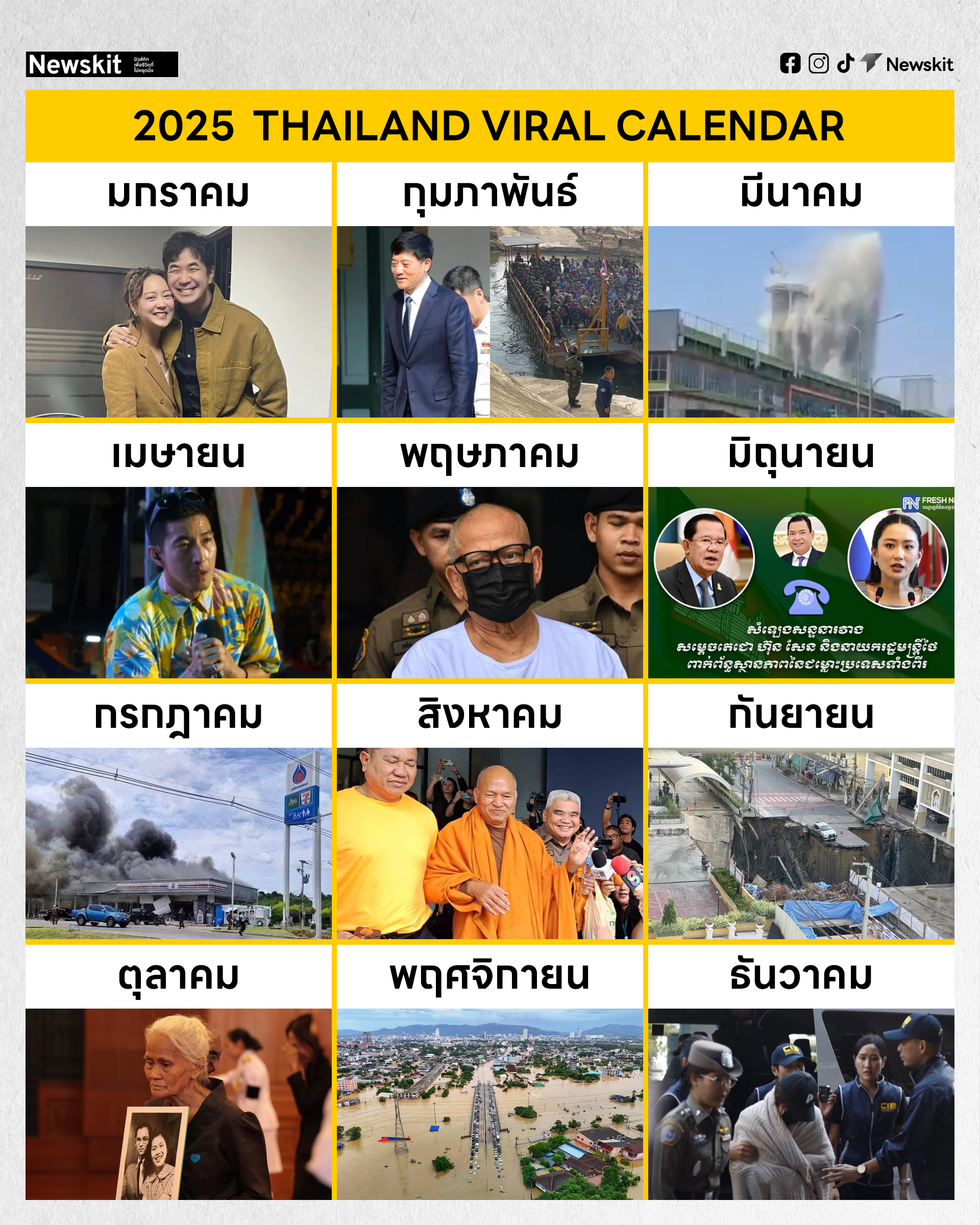(ลงโพสต์ย้อนหลังเนื่องจากระบบขัดข้อง)
2025 THAILAND VIRAL CALENDAR
วันคืนล่วงไป มีอะไรเข้ามาบ้าง Newskit ขอนำเสนอปฎิทินไวรัลในรอบปี 2568 สะท้อนเหตุการณ์ที่เป็นกระแสในช่วงที่ผ่านมา
มกราคม - นักร้องดัง แสตมป์ อภิวัชร์ กล่าวว่าหายไป 2 ปีเพราะภรรยาโดนคุกคาม แต่ถูกแฉกลับว่านอกใจภรรยาถึงขั้นมีคดีความ สุดท้ายเจ้าตัวยอมรับ
กุมภาพันธ์ - สแกมเมอร์จากกลุ่มจีนเทาไม่มีใครแก้ไขได้ หลิว จงอี้ ผู้ช่วยรัฐมนตรีจากจีน ต้องลงไปปราบเองให้ราบคาบ ตัดไฟ ตัดเน็ต รับชาวจีนกลับไปดำเนินคดีที่บ้านเกิด
มีนาคม - แผ่นดินไหวขนาด 8.2 จากประเทศเมียนมา สั่นสะเทือนถึงกรุงเทพฯ อาคาร สตง.แห่งใหม่ ย่านสวนจตุจักร สูง 30 ชั้นพังถล่มลงมา คนงานเสียชีวิต 89 ราย สูญหายอีก 7 ราย
เมษายน - นักร้องดัง โตโน่ ภาคิน ถูกแฉว่านอกใจแฟนสาว ณิชา ไปคบอดีตผู้ช่วยผู้จัดการส่วนตัว เจ้าตัวขอโทษที่ทำผิด ด้านณิชาบอกมูฟออนแล้ว ไม่มีรีเทิร์น
พฤษภาคม - จับกุมเจ้าคุณแย้ม เจ้าอาวาสวัดไร่ขิง จ.นครปฐม ยักยอกเงินวัดโอนให้สีกาคนสนิท เล่นพนันออนไลน์กว่า 300 ล้านบาท สองเดือนต่อมาจับกุมสีกากอล์ฟยั่วพระผู้ใหญ่ยักยอกเงินวัด ทำพุทธศาสนิกชนเสื่อมศรัทธา
มิถุนายน - คลิปเสียงอังเคิล ปล่อยโดย ฮุน เซน แห่งกัมพูชา คุยกับ แพทองธาร ชินวัตร นายกรัฐมนตรี ต่อรองผลประโยชน์ชาติ อยากได้อะไรบอกหลานจัดให้ ทำคนไทยทั้งประเทศไม่พอใจกล่าวหาขายชาติ
กรกฎาคม - กัมพูชาเปิดฉากใช้จรวด BM-21 ยิงใส่โรงพยาบาล บ้านเรือน ปั๊มน้ำมันฝั่งประเทศไทย เสียชีวิตกว่า 12 ราย เป็นจุดเริ่มต้นบาดแผลในใจคนไทย
สิงหาคม - จับกุมหลวงพ่ออลงกต เจ้าอาวาสวัดพระบาทน้ำพุ จ.ลพบุรี ทุจริตเงินบริจาควัดช่วยเหลือผู้ป่วยเอชไอวี เป็นทรัพย์สิน ที่ดิน รถยนต์ ปล่อยกู้ให้ชาวบ้าน เสียหายกว่า 1 หมื่นล้านบาท
กันยายน - หลุมยุบขนาดใหญ่หน้าโรงพยาบาลวชิรพยาบาล ระหว่างก่อสร้างอุโมงค์รถไฟฟ้าสายสีม่วง เตาปูน-ราษฎร์บูรณะ ทำรถยนต์กลืนหายไป อาคาร สน.สามเสนทรุดตัวต้องทุบทิ้ง สาเหตุน้ำกัดเซาะใต้ดินเป็นโพรงและอุโมงค์ชำรุด
ตุลาคม - ร่ำไห้ทั้งแผ่นดิน สมเด็จพระนางเจ้าสิริกิติ์ พระบรมราชินีนาถ พระบรมราชชนนีพันปีหลวง สวรรคตที่โรงพยาบาลจุฬาลงกรณ์ สิริพระชนมพรรษา 93 พรรษา
พฤศจิกายน - น้ำท่วมหาดใหญ่ ศูนย์กลางเศรษฐกิจภาคใต้ โดยมวลน้ำจากเขาคอหงส์และ อ.นาหม่อม บ้านเรือนจมน้ำเสียหายกว่า 1 แสนหลังคาเรือน เศรษฐกิจเสียหายกว่า 2 หมื่นล้านบาท
ธันวาคม - จับกุมนักแสดงสาว นานา ไรบีนา ข้อหาฉ้อโกงและความผิดตาม พ.ร.ก.กู้ยืมเงินฯ หลังผู้เสียหาย 17 รายแจ้งความถูกชักชวนลงทุนปล่อยกู้ เทรดหุ้น และร้านอาหารในต่างประเทศ ทั้งที่ไม่มีอยู่จริง เสียหายรวม 195 ล้านบาท
#Newskit
2025 THAILAND VIRAL CALENDAR
วันคืนล่วงไป มีอะไรเข้ามาบ้าง Newskit ขอนำเสนอปฎิทินไวรัลในรอบปี 2568 สะท้อนเหตุการณ์ที่เป็นกระแสในช่วงที่ผ่านมา
มกราคม - นักร้องดัง แสตมป์ อภิวัชร์ กล่าวว่าหายไป 2 ปีเพราะภรรยาโดนคุกคาม แต่ถูกแฉกลับว่านอกใจภรรยาถึงขั้นมีคดีความ สุดท้ายเจ้าตัวยอมรับ
กุมภาพันธ์ - สแกมเมอร์จากกลุ่มจีนเทาไม่มีใครแก้ไขได้ หลิว จงอี้ ผู้ช่วยรัฐมนตรีจากจีน ต้องลงไปปราบเองให้ราบคาบ ตัดไฟ ตัดเน็ต รับชาวจีนกลับไปดำเนินคดีที่บ้านเกิด
มีนาคม - แผ่นดินไหวขนาด 8.2 จากประเทศเมียนมา สั่นสะเทือนถึงกรุงเทพฯ อาคาร สตง.แห่งใหม่ ย่านสวนจตุจักร สูง 30 ชั้นพังถล่มลงมา คนงานเสียชีวิต 89 ราย สูญหายอีก 7 ราย
เมษายน - นักร้องดัง โตโน่ ภาคิน ถูกแฉว่านอกใจแฟนสาว ณิชา ไปคบอดีตผู้ช่วยผู้จัดการส่วนตัว เจ้าตัวขอโทษที่ทำผิด ด้านณิชาบอกมูฟออนแล้ว ไม่มีรีเทิร์น
พฤษภาคม - จับกุมเจ้าคุณแย้ม เจ้าอาวาสวัดไร่ขิง จ.นครปฐม ยักยอกเงินวัดโอนให้สีกาคนสนิท เล่นพนันออนไลน์กว่า 300 ล้านบาท สองเดือนต่อมาจับกุมสีกากอล์ฟยั่วพระผู้ใหญ่ยักยอกเงินวัด ทำพุทธศาสนิกชนเสื่อมศรัทธา
มิถุนายน - คลิปเสียงอังเคิล ปล่อยโดย ฮุน เซน แห่งกัมพูชา คุยกับ แพทองธาร ชินวัตร นายกรัฐมนตรี ต่อรองผลประโยชน์ชาติ อยากได้อะไรบอกหลานจัดให้ ทำคนไทยทั้งประเทศไม่พอใจกล่าวหาขายชาติ
กรกฎาคม - กัมพูชาเปิดฉากใช้จรวด BM-21 ยิงใส่โรงพยาบาล บ้านเรือน ปั๊มน้ำมันฝั่งประเทศไทย เสียชีวิตกว่า 12 ราย เป็นจุดเริ่มต้นบาดแผลในใจคนไทย
สิงหาคม - จับกุมหลวงพ่ออลงกต เจ้าอาวาสวัดพระบาทน้ำพุ จ.ลพบุรี ทุจริตเงินบริจาควัดช่วยเหลือผู้ป่วยเอชไอวี เป็นทรัพย์สิน ที่ดิน รถยนต์ ปล่อยกู้ให้ชาวบ้าน เสียหายกว่า 1 หมื่นล้านบาท
กันยายน - หลุมยุบขนาดใหญ่หน้าโรงพยาบาลวชิรพยาบาล ระหว่างก่อสร้างอุโมงค์รถไฟฟ้าสายสีม่วง เตาปูน-ราษฎร์บูรณะ ทำรถยนต์กลืนหายไป อาคาร สน.สามเสนทรุดตัวต้องทุบทิ้ง สาเหตุน้ำกัดเซาะใต้ดินเป็นโพรงและอุโมงค์ชำรุด
ตุลาคม - ร่ำไห้ทั้งแผ่นดิน สมเด็จพระนางเจ้าสิริกิติ์ พระบรมราชินีนาถ พระบรมราชชนนีพันปีหลวง สวรรคตที่โรงพยาบาลจุฬาลงกรณ์ สิริพระชนมพรรษา 93 พรรษา
พฤศจิกายน - น้ำท่วมหาดใหญ่ ศูนย์กลางเศรษฐกิจภาคใต้ โดยมวลน้ำจากเขาคอหงส์และ อ.นาหม่อม บ้านเรือนจมน้ำเสียหายกว่า 1 แสนหลังคาเรือน เศรษฐกิจเสียหายกว่า 2 หมื่นล้านบาท
ธันวาคม - จับกุมนักแสดงสาว นานา ไรบีนา ข้อหาฉ้อโกงและความผิดตาม พ.ร.ก.กู้ยืมเงินฯ หลังผู้เสียหาย 17 รายแจ้งความถูกชักชวนลงทุนปล่อยกู้ เทรดหุ้น และร้านอาหารในต่างประเทศ ทั้งที่ไม่มีอยู่จริง เสียหายรวม 195 ล้านบาท
#Newskit
(ลงโพสต์ย้อนหลังเนื่องจากระบบขัดข้อง)
2025 THAILAND VIRAL CALENDAR
วันคืนล่วงไป มีอะไรเข้ามาบ้าง Newskit ขอนำเสนอปฎิทินไวรัลในรอบปี 2568 สะท้อนเหตุการณ์ที่เป็นกระแสในช่วงที่ผ่านมา
มกราคม - นักร้องดัง แสตมป์ อภิวัชร์ กล่าวว่าหายไป 2 ปีเพราะภรรยาโดนคุกคาม แต่ถูกแฉกลับว่านอกใจภรรยาถึงขั้นมีคดีความ สุดท้ายเจ้าตัวยอมรับ
กุมภาพันธ์ - สแกมเมอร์จากกลุ่มจีนเทาไม่มีใครแก้ไขได้ หลิว จงอี้ ผู้ช่วยรัฐมนตรีจากจีน ต้องลงไปปราบเองให้ราบคาบ ตัดไฟ ตัดเน็ต รับชาวจีนกลับไปดำเนินคดีที่บ้านเกิด
มีนาคม - แผ่นดินไหวขนาด 8.2 จากประเทศเมียนมา สั่นสะเทือนถึงกรุงเทพฯ อาคาร สตง.แห่งใหม่ ย่านสวนจตุจักร สูง 30 ชั้นพังถล่มลงมา คนงานเสียชีวิต 89 ราย สูญหายอีก 7 ราย
เมษายน - นักร้องดัง โตโน่ ภาคิน ถูกแฉว่านอกใจแฟนสาว ณิชา ไปคบอดีตผู้ช่วยผู้จัดการส่วนตัว เจ้าตัวขอโทษที่ทำผิด ด้านณิชาบอกมูฟออนแล้ว ไม่มีรีเทิร์น
พฤษภาคม - จับกุมเจ้าคุณแย้ม เจ้าอาวาสวัดไร่ขิง จ.นครปฐม ยักยอกเงินวัดโอนให้สีกาคนสนิท เล่นพนันออนไลน์กว่า 300 ล้านบาท สองเดือนต่อมาจับกุมสีกากอล์ฟยั่วพระผู้ใหญ่ยักยอกเงินวัด ทำพุทธศาสนิกชนเสื่อมศรัทธา
มิถุนายน - คลิปเสียงอังเคิล ปล่อยโดย ฮุน เซน แห่งกัมพูชา คุยกับ แพทองธาร ชินวัตร นายกรัฐมนตรี ต่อรองผลประโยชน์ชาติ อยากได้อะไรบอกหลานจัดให้ ทำคนไทยทั้งประเทศไม่พอใจกล่าวหาขายชาติ
กรกฎาคม - กัมพูชาเปิดฉากใช้จรวด BM-21 ยิงใส่โรงพยาบาล บ้านเรือน ปั๊มน้ำมันฝั่งประเทศไทย เสียชีวิตกว่า 12 ราย เป็นจุดเริ่มต้นบาดแผลในใจคนไทย
สิงหาคม - จับกุมหลวงพ่ออลงกต เจ้าอาวาสวัดพระบาทน้ำพุ จ.ลพบุรี ทุจริตเงินบริจาควัดช่วยเหลือผู้ป่วยเอชไอวี เป็นทรัพย์สิน ที่ดิน รถยนต์ ปล่อยกู้ให้ชาวบ้าน เสียหายกว่า 1 หมื่นล้านบาท
กันยายน - หลุมยุบขนาดใหญ่หน้าโรงพยาบาลวชิรพยาบาล ระหว่างก่อสร้างอุโมงค์รถไฟฟ้าสายสีม่วง เตาปูน-ราษฎร์บูรณะ ทำรถยนต์กลืนหายไป อาคาร สน.สามเสนทรุดตัวต้องทุบทิ้ง สาเหตุน้ำกัดเซาะใต้ดินเป็นโพรงและอุโมงค์ชำรุด
ตุลาคม - ร่ำไห้ทั้งแผ่นดิน สมเด็จพระนางเจ้าสิริกิติ์ พระบรมราชินีนาถ พระบรมราชชนนีพันปีหลวง สวรรคตที่โรงพยาบาลจุฬาลงกรณ์ สิริพระชนมพรรษา 93 พรรษา
พฤศจิกายน - น้ำท่วมหาดใหญ่ ศูนย์กลางเศรษฐกิจภาคใต้ โดยมวลน้ำจากเขาคอหงส์และ อ.นาหม่อม บ้านเรือนจมน้ำเสียหายกว่า 1 แสนหลังคาเรือน เศรษฐกิจเสียหายกว่า 2 หมื่นล้านบาท
ธันวาคม - จับกุมนักแสดงสาว นานา ไรบีนา ข้อหาฉ้อโกงและความผิดตาม พ.ร.ก.กู้ยืมเงินฯ หลังผู้เสียหาย 17 รายแจ้งความถูกชักชวนลงทุนปล่อยกู้ เทรดหุ้น และร้านอาหารในต่างประเทศ ทั้งที่ไม่มีอยู่จริง เสียหายรวม 195 ล้านบาท
#Newskit






